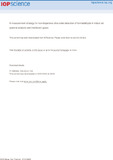JavaScript is disabled for your browser. Some features of this site may not work without it.
| dc.contributor.author | Davenport, John | |
| dc.contributor.author | Hodgkinson, Jane | |
| dc.contributor.author | Saffell, John R. | |
| dc.contributor.author | Tatam, Ralph P. | |
| dc.date.accessioned | 2016-04-15T14:14:54Z | |
| dc.date.available | 2016-04-15T14:14:54Z | |
| dc.date.issued | 2015-12-14 | |
| dc.identifier.citation | J J Davenport et al 2016 Meas. Sci. Technol. 27 015802 | en_UK |
| dc.identifier.issn | 0957-0233 | |
| dc.identifier.uri | http://dx.doi.org/10.1088/0957-0233/27/1/015802 | |
| dc.identifier.uri | https://dspace.lib.cranfield.ac.uk/handle/1826/9820 | |
| dc.description.abstract | We have conducted an extensive review of published spectra in order to identify a region with potential for detection of formaldehyde in indoor air. 85 chemicals and chemical groups common to the indoor environment were identified, 32 of which had absorption spectra in the UV-vis region. Of these, 11 were found to overlap with the formaldehyde UV region. It was found that the region between 320 to 360 nm is relatively free from interference from indoor gases, with NO being the only major interferent. A method is proposed for a low resolution (3 nm) spectroscopic detection method, specifically targeted at formaldehyde absorption features at 327 nm with a reference at 334 nm. 32 ppb of NO was found to have a cross-sensitivity with equivalent magnitude to 100 ppb of formaldehyde. A second reference at 348 nm would reduce this cross-sensitivity. | en_UK |
| dc.description.sponsorship | This work was funded by the Engineering and Physics Science Research Council (EPSRC) under grants GR/T18424, EP/P504880 and EP/H02252X. Enquiries for access to the data referred to in this article should be directed to researchdata@cranfield.ac.uk | en_UK |
| dc.language.iso | en | en_UK |
| dc.publisher | Institute of Physics | en_UK |
| dc.rights | Original content from this work may be used under the terms of the Creative Commons Attribution 3.0 licence. Any further distribution of this work must maintain attribution to the author(s) and the title of the work, journal citation and DOI. Attribution 3.0 Unported (CC BY 3.0). You are free to: Share — copy and redistribute the material in any medium or format Adapt — remix, transform, and build upon the material for any purpose, even commercially. The licensor cannot revoke these freedoms as long as you follow the license terms. Under the following terms: Attribution — You must give appropriate credit, provide a link to the license, and indicate if changes were made. You may do so in any reasonable manner, but not in any way that suggests the licensor endorses you or your use. Information: No additional restrictions — You may not apply legal terms or technological measures that legally restrict others from doing anything the license permits. | en_UK |
| dc.subject | Formaldehyde | en_UK |
| dc.subject | Gas sensing | en_UK |
| dc.subject | Non-dispersive ultra-violet | en_UK |
| dc.subject | NDUV | en_UK |
| dc.subject | UV spectroscopy | en_UK |
| dc.title | A measurement strategy for non-dispersive ultra-violet detection of formaldehyde in indoor air: Spectral analysis and interferent gases | en_UK |
| dc.type | Article | en_UK |
| dc.identifier.cris | 5378038 |
Files in this item
This item appears in the following Collection(s)
-
Staff publications (SATM) [4360]
